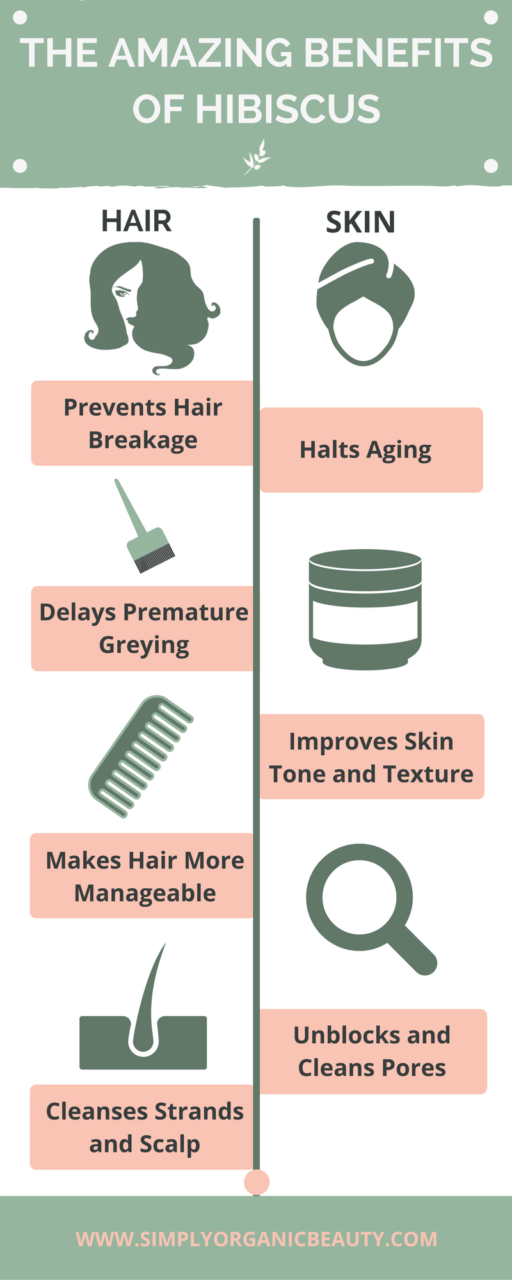Hibiscus flowers are not only beautiful to look at, but also offer great benefits for the skin and hair. Who would have thought that an unassuming backyard plant like Hibiscus can be the answer to many of our beauty problems?
A staple in Ayurvedic medicine and Chinese herbology, Hibiscus is traditionally consumed as tea to treat various digestive, respiratory, and urinary ailments. But due to its high vitamin and mineral content, its organic compounds have also become a common ingredient in many beauty products.
Natural Source of Alpha-Hydroxy Acid (AHA) and Amino Acids
Two of those compounds are Alpha-Hydroxy Acid and Amino Acid. You’ll know when a product contains AHA when you see glycolic acid, lactic acid, mandelic acid, or citric acid on the label. These compounds help reduce cell adhesion in the outermost layer of skin and hair without damaging and stripping them of their natural moisture—which can sometimes occur with synthetic AHAs.
Amino Acids, on the other hand, are necessary for producing keratin, which makes up the key structure of our hair and skin. In other words, for the body to produce healthy hair and skin cells, it must have sufficient access to these amino acids.
HOW HIBISCUS BENEFITS THE HAIR
Prevents Hair Breakage
Split ends? Brittle hair? It’s not a pretty sight, but it can be repaired. Bombarding our hair with different chemicals can rob it of its natural oil, causing it to lose moisture and snap. The AHAs in Hibiscus sloughs off all dirt and chemicals causing the damage and rehydrates the hair’s keratin fibers. It also contains plenty of amino acids which add much-needed strength and elasticity to the hair. Using protein sprays containing hibiscus extract, like OWAY’s Hrestore, is a perfect pre-treatment step before subjecting the hair to heat, styling, or coloring.
Delays Premature Greying
Finding grey hair can be a nightmare, especially if you’re too young to have one. Premature greying can be caused by many variables but it’s mainly due to slow production of melanin, the pigment that gives the hair its natural color, in the hair follicles. The lack of melanin is often attributed to genes, stress, vitamin-deficiency, and extrinsic factors like pollution and ammonia.
Because Hibiscus is chock full of antioxidants and vitamins essential for melanin production, it helps prevent premature greying by nourishing the hair shafts before they even start to lose pigment.1 OWAY Hcolor contains biodynamic Hibiscus and zero ammonia (an industrial bleaching agent that strips the hair of its natural color) so it does not only provide the hair the nutrients it needs for healthier strands, but it also protects it from further fading.
Makes Hair More Manageable
Mucilage – the thick, gluey substance produced by Hibiscus for storing water – is intensely hydrating. It lubricates each strand, allowing for easier detangling while adding softness and shine to the hair shaft. It’s like a leave-in conditioner, without the harsh chemicals.

Cleanses Strands and Scalp
When our scalp produces excess sebum, it can lead to many problems such as dandruff, scalp acne, itchiness, and frizzy hair. When this happens, it means that the pH level of the scalp is too high, and needs to be balanced — STAT.
The organic compounds obtained from Hibiscus contain significant amounts of citric acid and antioxidants that it’s acidic enough to be used as a pH-balancing agent.2 These compounds regulate the scalp’s oil production and strip the hair of all pollutants while maintaining their natural protection barriers.
Before doing any service, make sure to cleanse the hair first. Otherwise, you’ll be exposing the hair to more damage. We recommend using OWAY Htech Shampoo to prepare the hair fibers for any technical service.
HOW HIBISCUS BENEFITS THE SKIN
Halts Aging
Many skincare products claim that they have discovered the Fountain of Youth. When in reality, it’s really not that hard to find. In fact, hundreds of different species of it grow in warm, tropical regions around the world.
The AHA and anti-oxidant contents of Hibiscus act as pore-reducing agents and exfoliants that scrub off dead skin cells. In addition, the mucilage is an effective moisturizer. Combine all these elements together, and you have an anti-aging ingredient that with constant use, gives skin a younger, suppler appearance.
Improves Skin Tone and Texture
The citric acid in Hibiscus accelerates cell turnover, which is beneficial to those who suffer from hyperpigmentation. There are several causes of hyperpigmentation, but the most common are overexposure to the sun and pollution. Citric acid reverses the damage caused by free radicals and UV rays through exfoliation, resulting in a more even skin tone and smoother texture.
To speed up the process, Hibiscus can be added to products containing natural scrubs, such as Luma Lisse Lustrous Micro Polish.
Unblocks and Cleans Pores
Every day, our skin battles with sweat, dirt, and pollution. And if you have especially oily skin, they could clog your pores and lead to blackheads – or worse, pimples. Hibiscus has natural surfactants that help cleanse the skin in a mild, soothing way. They act as magnets for excess oil, dirt, and bacteria, and gently wash them away without drying out the skin—a common issue with skincare products using chemical surfactants.3
Hibiscus is only one of the many natural ingredients that offer countless benefits to our hair and skin, so why should we ever want to use harsh chemicals for our beauty needs? Some chemically-based products may be more accessible and promise quick results, but the effects often don’t last long and can even cause more harm than good. With natural ingredients, you get even better efficacy, minus the harsh drawbacks.
SOURCES
1 Singh, V et al. (2015). Study of colouring effect of herbal hair formulations on graying hair. Available: https://www.ncbi.nlm.nih.gov/pmc/articles/PMC4471652/
2 Okoduwa, S et al. (2015). Comparative Analysis of the Properties of Acid-Base Indicator of Rose (Rosa setigera), Allamanda (Allamanda cathartica), and Hibiscus (Hibiscus rosa-sinensis) Flowers. Available: https://www.hindawi.com/journals/bri/2015/381721/.
3 Paula’s Choice. Surfactant. Available: ttp://www.paulaschoice.com/cosmetic-ingredient-dictionary/definition/surfactant.




